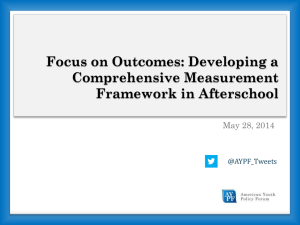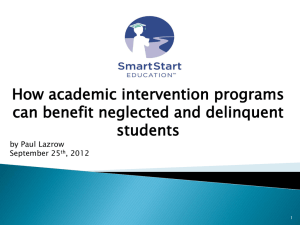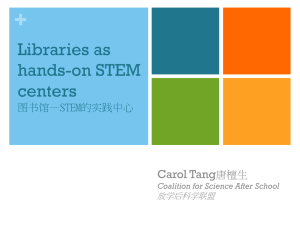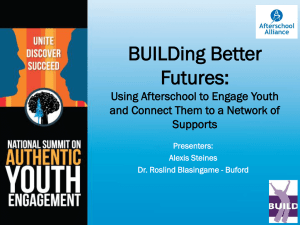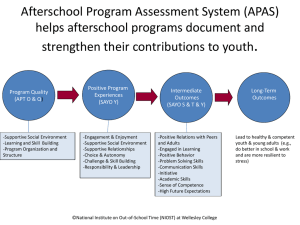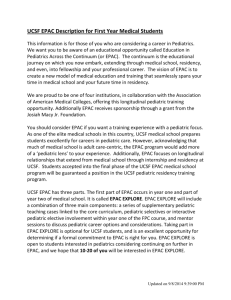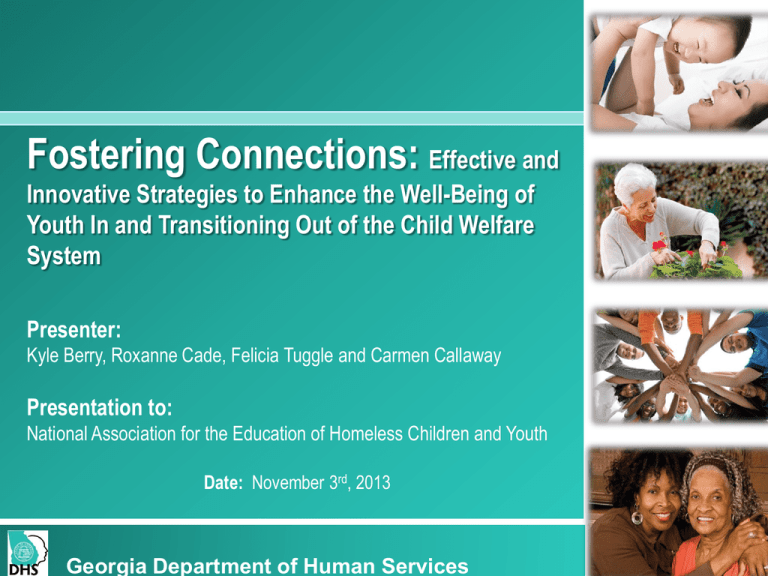
Fostering Connections: Effective and
Innovative Strategies to Enhance the Well-Being of
Youth In and Transitioning Out of the Child Welfare
System
Presenter:
Kyle Berry, Roxanne Cade, Felicia Tuggle and Carmen Callaway
Presentation to:
National Association for the Education of Homeless Children and Youth
Date: November 3rd, 2013
Georgia Department of Human Services
Vision, Mission, and Core Values
Vision
Stronger Families for a Stronger Georgia.
Mission
Strengthen Georgia by providing Individuals and Families access to services
that promote self-sufficiency, independence, and protect Georgia's
vulnerable children and adults.
Core Values
•
•
•
•
•
Provide access to resources that offer support and empower Georgians and
their families.
Deliver services professionally and treat all clients with dignity and respect.
Manage business operations effectively and efficiently by aligning resources
across the agency.
Promote accountability, transparency and quality in all services we deliver
and programs we administer.
Develop our employees at all levels of the agency.
2
Educational Programming, Assessment
and Consultation
The Need for Education Services
IEP or 504
Retained
Suspended or
Expelled
Multiple School
Transfers
5,013 School-Aged
Foster Youth (K-12)
Failing
Standardized
Tests
Reading below
Grade Level
Trauma/Neglect
At the end of Federal Fiscal Year 2013, 87% (4,362) of GA foster
youth had been referred to and served by EPAC.
Educational Programming, Assessment, and Consultation
Overview
The EPAC Unit provides comprehensive academic support services
focusing on improving educational outcomes and the academic
achievement of children and youth, ages 5 to 17 in the custody of
Georgia Division of Family and Children Services. EPAC services are
supported through TANF funding and are initiated through case
manager or CPS referrals. Upon initial placement into foster care,
children and youth are referred to EPAC for a comprehensive
diagnostic educational assessment and subsequently, are monitored
for ensuring adequate academic progress.
Educational Programming, Assessment, and Consultation
Overview (continued)
EPAC currently has 15 Education Support Monitors (ESMs) who
manage educational services for all school aged youth in care.
ESMs are assigned regionally to provide individualized case
consultation and to assist case managers in linking children and
youth to local education support services, while adhering to local
school district policies and procedures. Additionally, EPAC is
responsible for procuring educational services from either within the
community, local education agencies or EPAC program assigned.
During this current fiscal year, EPAC has contracted with over 230 certified
Georgia Teachers who provide specific, one-on-one academic support.
Educational Programming, Assessment, and Consultation
Services Continuum
Reevaluation
of Educational
Need
Referrals
Resource
Management
Assessments
Delivery of
Services
Educational
Records
DFCS EPAC
Action Plan
Core EPAC Services
Educational
Advocacy
Local
Resource
Management
Contract
Monitoring
3 Tier EPAC Service Model
3 Tier Service Model
Educational Advocacy
Resource Management
Contract Monitoring
Diagnostic Educational
Assessment & development of
Educational Action Plans
Educational Resource
Coordination
EPAC Tutorial Services
Training and Staff
Development
Community Programs &
Partnerships
Educational Transportation
Services
Consult and/or attend case
staffing, IEP meetings,
Transitional Round Tables,
etc…
Local Education Agencies and
GA Department of Education
•SLDS
•FLIP/Title 1
Summer School and Credit
Recovery Services
Educational Stability
DHS POLICY # 10.13
Educational Programming, Assessment, and Consultation
DHS Policy 10.13 – Education Stability
•
This policy was disseminated to the field on August 1, 2013
•
It provides practice guidance to direct service workers and all other field staff about
Education Stability for children and youth in foster care
•
This policy specifically covers how EPAC, through its Education Support Monitors,
engage case managers and provide educational consultation in the following areas:
– Collaborations with Local Educational Agencies (LEAs)
– Determination of Appropriateness of Educational Settings
– DFCS contact for District Level Homeless Liaisons
– Assist in development of RTI, IEP, and/or 504 Plans
– Homeless and Unaccompanied Youth Referrals
– Educational Stability Transportation Funding Request Protocol
Educational Stability
Educational Stability is essential to a child’s
well-being. It is imperative that DFCS Case
Managers and other direct service staff
responsible for case planning, engage in the
necessary steps to make best interest
determinations regarding the stability of
educational settings for children and youth as
they enter and remain in care.
McKinney-Vento vs. Fostering Connections
Homeless and Unaccompanied Youth
When a child has been identified as a Homeless and/or Unaccompanied Youth,
the following procedure will be followed by the Division of Family and
Children Services In-take Officer(s).
1. When an identified homeless or unaccompanied youth has been identified to
CPS/In-Take, a referral form (176) will be completed and submitted to Educational
Programming, Assessment and Consultation Unit (EPAC).
2. Referral form will be processed by EPAC (Operations Analyst) who will record the
provided information in the Homeless & Unaccompanied Youth (HUY) Data
System.
3. Based upon the Local Educational Agency identified on the referral, EPAC will
contact the appropriate Homeless Liaison who should then direct services for the
youth under the guidelines of McKinney-Vento.
4. EPAC/DFCS will periodically check-in with the Homeless Liaison to ensure
services were provided to youth.
Steps to Ensure Educational Stability
Educational
Stability Field
Guide
Educational
Stability Checklist
Education
Transportation
Funding Request
Protocol
Transportation Protocol to Support Educational Stability
Educational Stability transportation funds should
be used to support the practice of ensuring
foster children and youth remain in their home
school/school of origin as part of Educational
Stability
Transportation Considerations
Transportation Options
• Foster Parent
• Public transportation/Mass
Transit
• Van pools
• Taxis
• Private transportation services
Determining Factors
•
•
•
•
Age of child/youth
Location of placement and
distance from school of
origin
Child/youth’s physical and
cognitive abilities
Child/youth’s
developmental abilities
Reasonable Distance Determination
The following considerations should be made when
determining if the school of origin is an unreasonable
distance from the child/youth’s placement:
• Does the commute exceed one hour (one-way) or 60 miles in
distance (one-way)? REMINDER: Foster parents/caregivers can
provide transportation to ensure educational stability for
distances of 25 miles or less.
• Will the cost of the services exceed $2,000.00 per month?
Internal and External
Stakeholders
EPAC PARTNERS
For more information, please you may reach me
(Kyle D. Berry) at:
404-657-5122
or
by email at kyberry@dhr.state.ga.us.
Independent Living Program Overview
The State of Georgia recognized that without appropriate services,
planning and support, our youth would not have a successful
transition foster care. Our youth showed higher rates of
homelessness, unemployment, poverty, delinquent or criminal
behaviors and dependence on various types of public
assistance.
In response, the State of Georgia implemented the standards and
support of the Chafee Foster Care Independence Program (CFCIP)
which provided states with greater funding to prepare foster youth for
the transition to adulthood.
ILP Mission
Is to provide eligible youth with
opportunities to successfully prepare
for adulthood, by providing
appropriate resources and
connections with community partners.
ILP Outcome Measures
Our program comprise of six outcome measures targeting:
•
•
•
•
•
•
education attainment;
financial self-sufficiency;
avoidance of homelessness;
positive connections with adults;
avoidance of high-risk behaviors; and
accessing health insurance.
These outcomes assess our performance in the delivery of
services and support to ensure successful transitions.
Services and Programs
• To achieve successful outcomes, we provide an
assortment of services such as educational
workshops/conferences, independent living skills
needs assessment, post secondary supports,
academic supports, financial assistance, employment
programs/training, Individual Development Accounts
Matching Program and monitoring of the Written
Transition Living Plan.
Eligible Youth for SFY13
A total of 2588 youth were eligible to receive ILP services. Out of the 2588,
2385 youth or young adults in and out of foster care received ILP
services/support.
ILP Funded Supports/ Services
Education &
• Tutoring , Summer School, Community Activities,
Driver's Education, GED Preparation
Enrichment Expenses
Transitional Living
• Partial Rental Reimbursement, Utility Deposits,
Rental Deposits, Emergency Assistance
Post Secondary
• Tutoring, Tuition, Books, Room and Board,
Transportation Assistance.
Educational Expenses
Individual Development • Savings Account Matching, Stipends.
Account (IDA)
Some ways youth can be supported using ILP funds. This is not an
extensive list. Specific monetary limits are based upon availability of
funds and the specific needs of the youth.
Education and Enrichment Expenses
SPECIFIC
SERVICE REQUIREMENT
DESCRIPTION
HOW DO YOU ACCESS
SERVICES?
Summer or Evening School Fees
Skills Conferences, Trainings, and
Workshops
Personal Computers and Printers
Graduation Fees
Non-Essential Graduation Fees
Independent Living life skills,
SSCM must obtain approval
conferences, training, workshops through the ILS. Once funds
have been approved, then the
Personal computers and printers, provider can purchase the items,
if required by the school
or pay for workshops/
conferences. Original receipts
must have the provider and
youths signature on them.
Receipts are then submitted to
class ring, senior pictures,
the SSCM which will submit to
announcements/invitations,
the ILS for reimbursement.
yearbooks, etc NOT to exceed
$350.00 total and youth must
have senior classification
Education and Enrichment Expenses
SPECIFIC
SERVICE REQUIREMENT
DESCRIPTION
Tutoring Through
EPAC
Driver’s Education
HOW DO YOU ACCESS
SERVICES?
Tutoring (up to $1500.00 academic per year)
Children (ages 5 to 17) must be referred to EPAC SSCM would submit a referral to
ILP eligible youth ages 14-21 who are not or the EPAC
become no longer EPAC supported tutoring may
be supported by ILP funds
$500 limit
Promotes the well-being of ILP eligible foster
children 14 and older by providing them with
enrichment activities through programs such as
Red Cross, YMCA, summer camps/community
workshops, church camps, classes (dance, art,
sports, band, swimming, karate and music
lessons)
Not to exceed $250.00 per activity/fiscal year for
non-school related activities.
Enrichment/Safety
Activities
SSCM must obtain approval
through the ILS. Once funds
have been approved, then the
provider can purchase the items
or class. Original receipts must
have the provider and youths
signature on them. Receipts are
then submitted to the SSCM
which will submit to the ILS for
reimbursement.
Education and Enrichment Expenses
DESCRIPTION
Extra-Curricular Activities
Transportation to ILP
Activities
Support Groups
Testing/Test Preparation and
College Application Fees
SPECIFIC
SERVICE REQUIREMENT
HOW DO YOU ACCESS
SERVICES?
Band, band uniforms, instruments, athletics,
cheerleading, and school sponsored clubs, etc
SSCM must obtain approval
Transportation to and from ILP Sponsored
through the ILS. Once funds
activities
have been approved, then the
provider can pay for the
services. Original receipts must
Support groups such as Ala-non, Ala-teens,
anger management, stress management, parent have the provider and youths
signature on them. Receipts are
education, child development, etc
then submitted to the SSCM
Testing and test preparation for undergraduate which will submit to the ILS for
and graduate admission, includes youth who are reimbursement.
applying to college, and preparing to take the
ACT/SAT
Post Secondary Education Support
DESCRIPTION
Tuition, Registration, Fees
SPECIFIC
SERVICE REQUIREMENT
HOW DO YOU ACCESS
SERVICES?
Tuition, registration, and fees, such as
athletic activities, technology, etc
Books, Supplies, Tools and
Equipment
Room and Board – On
Campus
Room and Board – Off
Campus Board
Room and board (on-campus housing)
On-campus housing should be paid directly
to the vendor (i.e. school, education
institution)
Room (off-campus housing), the off-campus
housing is limited to ½ the rental rate or
$300.00 whichever is less
Off Campus Housing should be a
reimbursement paid directly to the client upon
receipt of payment to the ILS
Youth must apply for Post
Secondary Education by 7/1/13.
Applications are provided
through the ILS.
Post Secondary Education Support
DESCRIPTION
SPECIFIC
SERVICE REQUIREMENT
HOW DO YOU ACCESS
SERVICES?
Uniforms and Supplies
Uniforms and supplies for training programs
Youth must apply for Post
Secondary Education by 7/1/13.
Applications are provided
through the ILS.
Personal Computers/Printers
Personal computers and printers, if required by
the school
Youth must attend a Computer
Conference thru the ILP.
Tutoring Through EPAC
Tutoring (up to $1500.00 academic per year)
Stipends – On Campus
Subsistence stipend as needed
Youth living on-campus with a meal plan are
eligible for a $75 stipend monthly
Youth living on-campus and do not have an oncampus meal plan are eligible for a $150
stipend monthly
Youth must apply for Post
Secondary Education by 7/1/13.
Applications are provided
through the ILS.
Post Secondary Education Support
DESCRIPTION
SPECIFIC
SERVICE REQUIREMENT
HOW DO YOU ACCESS
SERVICES?
Stipends – Off Campus
Subsistence stipend as needed
Youth living off-campus and do not have an oncampus meal plan are eligible for a $150
stipend monthly
Transportation
Youth must apply for Post
Transportation assistance – not to exceed
Secondary Education by 7/1/13.
$650.00 per state fiscal year and cannot be
Applications are provided
used toward purchase, maintenance or insuring
through the ILS.
of a personal vehicle
Testing and Test Preparation
Testing and test preparation for undergraduate
and graduate admission, includes youth who are
applying to college, and preparing to take the
ACT/SAT)
Education Status Support
2012-2013 School Year
Total Awarded Post
Secondary Support
Number of New Youth
Receiving Support
366
104
(July 1, 2012 to June 30, 2013)
This past school year, the GA Division of Family and Children Services had 34
college youth graduate as well as 264 General Education Development
(GED) and high school youth.
Helping Homeless Youth In Your State
Population
of Youth
Youth in care
or formerly in
foster care
Homeless
Youth
Need
State of GA
Your State
Education
•Utilize Education and Training Vouchers/State
Funds and Chafee Funds to support youth
academically
•Contact your Child Welfare Agency
Independent Living Unit to explore youth options
for education support from High School to Post
Secondary
Housing
•Private Placement Providers- State contract
•Utilize Chafee funds for housing support
•ETV and State Funds for Room and Board
Assistance
•Emergency Assistance
•KickStart Program- Housing Authority (Family
Unification Program)
•Contact your Child Welfare Agency
Independent Living Unit /Case Manager to
explore Housing options and assistance for
youth.
Education
Housing
•Refer youth to government program for homeless
youth (ex. Atlanta Workforce Development AgencyGED)
•Refer youth Post Secondary Institutions who have
special programs to support population (ex.
University of GA & Kennesaw State University).
•Refer Youth to Financial Aid Assistance
Program/Scholarships
•Refer youth to community partners and resources
•Research community and government
programs to support homeless youth/ young
adults.
•Refer Youth to Financial Aid Assistance
Program/Scholarships
•Engage post secondary institutions on the
services and supports they provide to the
homeless population
•Refer youth to homeless housing programs for
youth (ex. Covenant shelter and transitional program/
ChrisKids HUD Housing Program, Housing Authority)
Refer youth to homeless housing programs for
youth (ex. Shelters, Transitional Programs, City
Housing Authority-Section 8 Vouchers)
TPP & Education, What’s the Connection?
• Data show negative associations between sexual
risk behaviors and academic achievement
• Students with high grades are significantly less
likely to engage in risky behaviors such as:
- Having sex before age 13
- Having sex with 4+ people
- Drinking alcohol or using drugs before sex
- Not using a condom during sexual intercourse
Source, CDC Sexual Risk Behaviors and Academic Achievement Fact
Sheet, 2011
Science Says…Homeless Youth are:
•
•
•
•
•
•
•
•
•
More likely to drop out of school
Suffer from chronic health disorders
Engage in survival sex
Are at greater risk of contracting AIDS, HIV-related illnesses,
and other STDs
Are more likely to suffer from anxiety disorders, depression,
posttraumatic stress disorder and suicide
Are at increased risk of being physically and sexually abused
More likely to use and abuse drugs
More likely to be involved with the juvenile justice system
Lack many skills that are crucial to life in the adult world
What is PREP?
Personal Responsibility Education Program
• Federally funded program to educate youth on both
abstinence and contraception for the prevention of
pregnancy and sexually transmitted infections,
including HIV/AIDS - and 3 of 6 legislatively
mandated adulthood preparation subjects
States Receiving Funding by Year of Receipt
Georgia’s PREP Initiative
• Mission
– To provide evidence-based programming to high priority youth ages
10-19 in an effort to educate and promote personal responsibility
• Vision
– Through a unified state initiative, provide high risk youth in 10
Georgia counties with free access to evidence-based teen
pregnancy prevention programs and supplemental adult preparation
subjects
• Goals
– Educate youth to make healthy and responsible decisions
– To reduce the risk of pregnancy, HIV and STI’s among high priority
youth ages 10-19 (up to 21 if pregnant and/or parenting)
Overview of GA-PREP
Target
Populations
Foster Youth, Homeless Youth, Youth
involved in Juvenile Justice, LGBTQ,
Pregnant and Parenting, African
American, and Latino Youth
Program
Models
•Making a Difference
•Making Proud Choices
•Be Proud, Be Responsible, Be
Protected
•Relationship Smarts+
•Keys to our Financial Future
Adult
Preparation
Subjects
46
•Healthy Relationships
•Healthy Life Skills
•Adolescent Development
•Financial Literacy
•Career Preparation
1
5
1
1
1
1
=10 PREP
Implementation Counties
FFY’13
GA-PREP Provided Funding to 20 Sub-Awardees = 57 unique implementation sites
PREP Implementation Settings
What have learned from youth?
At Entry:
47% of surveyed PREP participants report having had
sexual intercourse
44% of surveyed PREP participants report intention to
have sexual intercourse in the next year
During the 6 months prior to participating in PREP
– 48% had not received information on birth control
– 47% had not received pregnancy testing
– 48% had not received STD testing or treatment
Vulnerable Youth + Risky Behaviors = Negative Outcomes
Celebrating Success
At Exit:
40% of participants were more likely to abstain from
sexual intercourse in the next year
68% of participants were more likely to use or ask a
partner to use a condom
62% of participants were more likely to use or ask a
partner to some method of birth control
At exit, surveyed PREP participants reported they were more
likely to:
Care about doing well in school (63%)
Continue education (64%)
Set personal goals (61%)
Form healthy positive relationships (60%)
Positively manage conflict in relationships (50%)
Say no/resist peer pressure (52%)
Manage money carefully (55%)
How does PREP support homeless youth?
• Provide comprehensive health education
• Provide linkages to clinical services (teen clinics)
and community resources
• Provide youth focused relationship education
• Provide career preparation and financial literacy
• Provide opportunities for youth to develop positive
supportive connections with adults and peers.
• Provide training to adult caregivers/providers to help
them become “Askable Adults”.
State PREP Programs can help you
support homeless youth
1. Identify PREP programs in your state
2. Refer youth to participate
3. Follow-up with youth
Current Afterschool Statistics
The hours between
3 p.m. and 6 p.m.
are the peak hours for
juvenile crime and
experimentation with
drugs, alcohol, cigarettes
and sex.
(Fight Crime: Invest in Kids, 2002)
Current Afterschool Statistics
• More than 15 million school-age children (26 percent) are
on their own after school. Among them are more than 1
million are in grades K through 5. (Afterschool Alliance,
2009)
• More than 27 million parents of school-age children are
employed, including 23 million who work full time. (U.S.
Department of Labor, 2010)
Information retrieved from the Afterschool Alliance, www.afterschoolalliance.org.
DFCS Afterschool Care Program
The Afterschool Care Program is located within the Georgia Department
of Human Services (DHS), Division of Family and Children Services
(DFCS), Community Programs Unit.
The program provides federal funding to non-profit organizations and
public agencies who serve youth and families during the out-ofschool time and is designed to support DHS’ broader goal of
promoting self-sufficiency among families and ending
intergenerational poverty.
DFCS Afterschool Care Program
Mission
To provide resources to youth-serving organizations within
the state of Georgia who serve families within low tomoderate income communities and the foster care system.
Vision
To ensure every child and youth has access to high quality
youth development programming within their community.
DFCS Afterschool Care Program
Goals
•
Strengthen youth-serving organizations and institutions by providing funding that
increases their capacity to design, implement, and sustain quality youth development
programs that provide services to underserved youth;
•
Strengthen youth by providing opportunities for them to establish a relationship with a caring
adult, participate in project-based and/or apprenticeship-based learning experiences and
engage in year-round or summer enrichment experiences that prepare for life beyond the
school-age years;
•
Strengthen families by informing them of available resources within their communities; and
•
Strengthen communities by supporting relationship building, coordinating service delivery,
and building the capacity of local institutions and organizations to meet the needs of youth,
specifically youth who are in foster care and youth who have special needs.
DFCS Afterschool Care Program
By funding youth development services that are provided during before
school, after school, intercession and summer, the Afterschool Care
Program also supports two Temporary Assistance for Needy Families
(TANF) goals:
(a) Reduce the dependency of needy parents by promoting job
preparation, work and marriage; and
(b) Prevent and reduce unplanned pregnancies among single young
adults.
DFCS Afterschool Care Program
Funded Programs Provide:
1. Apprenticeship Opportunities (high school youth)
2. Project-based Learning Opportunities (elementary and middle youth)
3. Well-being and Enrichment Activities (all youth)
DHS DFCS Afterschool Care Program Framework of Service
SHORT TERM RESULTS FOR YOUTH
IN FUNDED AFTERSCHOOL AND
SUMMER PROGRAMS
Provide
Funding to
Afterschool
and Summer
Programs that
serve youth in
low-tomoderate
communities.
Ensure primary
components of
programs
include
academic
enrichment
activities,
health
education,
physical
activity and
teen
employment
opportunities.
Achieve and Maintain Good Grades ∙ Increased High School Graduation
Rate ∙ Increased Engagement in Learning
Provide
technical
assistance
to funded
programs
that assist in
program
quality
improvement
and funding
compliance.
Provide
resources
for additional
internal and
external
funding and
professional
development
opportunities
that improve
program
quality.
Youth in Funded
Programs are1:
SAFE
HEALTHY
EDUCATED
EMPLOYABLE
CONNECTED
LONG TERM RESULTS FOR YOUTH IN FUNDED AFTERSCHOOL AND SUMMER PROGRAMS
Graduation from a post secondary institution or employment (livable wage)
Healthy and safe relationships
Community service
Active participation in community
1
Format adopted from Voices for Georgia’s Children and Ready by 21™: Karen Pittman, Founder of the Forum for Youth Investment,
www.forumforyouthinvestment.org
Created by the DHS Afterschool Services – Updated 7/27/09
DFCS Afterschool Care Program
If youth are Safe, Healthy, Educated, Employable
and Connected, they are more likely to:
1. Receive an Education
2. Delay Childbirth
3. Delay Marriage
DFCS Afterschool Care Program
Federal Fiscal Year 2013
Total Number of Counties Served 74
Number of Funded Afterschool Providers
Community Based Organizations: 41
Schools/Public Agencies: 19
Total: 60
Total Number of Afterschool Provider Sites
Community Based Organizations: 285
Schools/Public Agencies: 68
Total: 353
DFCS Afterschool Care Program
Federal Fiscal Year 2014
Total Number of Counties Served 69
Number of Funded Afterschool Providers
Community Based Organizations: 32
Schools/Public Agencies: 9
Total: 41
Total Number of Afterschool Provider Sites
Community Based Organizations: 229
Schools/Public Agencies: 34
Total: 263
Connecting Youth to Programs
To ensure youth are connected to funded programs, the Afterschool Care
Program has implemented a “three-village” approach:
Homeless Liaisons and
representatives from the
Department of Juvenile
Justice are able to make
referrals for youth
Funded Agencies
directly contact their
local family service
departments (ie.
Georgia County
Departments of Family
and Children Services)
Case Managers at the
local family service
departments are able
to make referrals for
youth
For more information, please you may reach me
(Carmen C. Callaway) at:
404-657-4651
or
by email at cccallaway@dhr.state.ga.us.
Open Q & A



